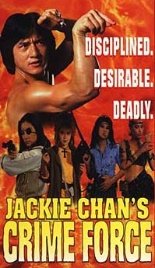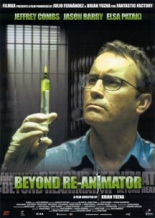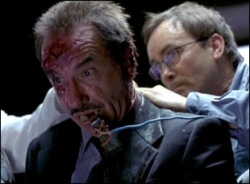
 As expected, Jackie Chan is hardly in Jackie Chan’s Crime Force. But it doesn’t matter — the movie succeeds in being entertaining in its own plotless, over-the-top manner without him.
As expected, Jackie Chan is hardly in Jackie Chan’s Crime Force. But it doesn’t matter — the movie succeeds in being entertaining in its own plotless, over-the-top manner without him.
Known in some public-domain circles as Golden Queen’s Commando, it’s a crazy-Asian female version of The Dirty Dozen, minus five protagonists. The opening sequence introduces us to each of the felonious females, including the eyepatch-wearing Black Fox, the tattooed Amazon, the fright-wigged Black Cat, the pickpocketing Quick Silver, the whore Sugar, the pyrotechnic Dynamite and some alcoholic chick whose name I didn’t catch because the titles are poorly framed and cut off.
Upon her arrival in prison during World War II, Black Fox (Brigitte Lin of Chungking Express and Police Story) double-crosses each of the girls so they’ll all end up in the hole together. There she hatches an escape plan, and while it does gets the movie rolling, it denies us the usual women-in-prison clichés to which American renters are so pruriently accustomed (subbing a ballet-like basketball game and Keystone Kops-esque food fight instead).
 Once they flee on horseback, Black Fox reveals they’ve been recruited to help her infiltrate an evil warlord’s chemical weapons plant. In a booby-trapped forest, they encounter the usual dangers — nets, spikes, sword-wielding skeletons — and are soon captured, but are allowed to go free when they beat their enemies at their own games — namely archery, blindfolded balloon shooting and noodle-eating.
Once they flee on horseback, Black Fox reveals they’ve been recruited to help her infiltrate an evil warlord’s chemical weapons plant. In a booby-trapped forest, they encounter the usual dangers — nets, spikes, sword-wielding skeletons — and are soon captured, but are allowed to go free when they beat their enemies at their own games — namely archery, blindfolded balloon shooting and noodle-eating.
Following a brief interlude in haunted woods, the girls finally arrive at the cat-stroking warlord’s Enter the Dragon-ish secret cave lair. Said warlord is portrayed for all of about two minutes by Chan. This is the best part, however, because the chicks shoot a lot of minions and do flips. You get all this plus severed limbs, a rat pierced with a chopstick and a fat guy named, well, Fatty. Arguably it’s the silliest thing Chan’s ever done outside of Fantasy Mission Force, yet still a better career move than The Medallion. —Rod Lott



 The story (with apologies to the word “story”) has Gooding brokenhearted after his girlfriend (Vivica A. Fox) dumps him when he barfs on her cleavage and proposes marriage. To cheer him up, his ultra-horny janitor pal Sanz convinces him to accompany him on a cruise to engage in lots of promiscuous sex with loose women. But unbeknownst to them, a vengeful travel agent (Will Ferrell, whose cameo is the film’s only saving grace, outside of Victoria Silvstedt’s purple panties) books them on an all-male, all-gay ship. Let the homophobia ensue!
The story (with apologies to the word “story”) has Gooding brokenhearted after his girlfriend (Vivica A. Fox) dumps him when he barfs on her cleavage and proposes marriage. To cheer him up, his ultra-horny janitor pal Sanz convinces him to accompany him on a cruise to engage in lots of promiscuous sex with loose women. But unbeknownst to them, a vengeful travel agent (Will Ferrell, whose cameo is the film’s only saving grace, outside of Victoria Silvstedt’s purple panties) books them on an all-male, all-gay ship. Let the homophobia ensue!
 H.P. Lovecraft’s demented Dr. Herbert West made a third house call with the long-overdue
H.P. Lovecraft’s demented Dr. Herbert West made a third house call with the long-overdue  I’ll admit I harbored strong reservations about Beyond; the fact that it was shot in Spain, set in a prison, scripted by a first-timer and had no principals return except Combs combined to portend an idea whose time had long passed. Plus, director Brian Yuzna’s spotty filmography —
I’ll admit I harbored strong reservations about Beyond; the fact that it was shot in Spain, set in a prison, scripted by a first-timer and had no principals return except Combs combined to portend an idea whose time had long passed. Plus, director Brian Yuzna’s spotty filmography — 
 That’s comprised mostly of one guy (George Diamond) who looks like Joe Mantegna’s second cousin. He’s trained in “subversive activities” and must find Prince Radolpho’s computer terminal. To do this, he’s given some gadgets that look assembled from various cast-off parts in Radio Shack’s bargain bin. This film’s Q rattles them off: “a rotational axis with combined sensor … and last but not least, your acid pen.” Replies our hero, “I hope it doesn’t leak in my pocket!”
That’s comprised mostly of one guy (George Diamond) who looks like Joe Mantegna’s second cousin. He’s trained in “subversive activities” and must find Prince Radolpho’s computer terminal. To do this, he’s given some gadgets that look assembled from various cast-off parts in Radio Shack’s bargain bin. This film’s Q rattles them off: “a rotational axis with combined sensor … and last but not least, your acid pen.” Replies our hero, “I hope it doesn’t leak in my pocket!”
 Whether you call it Thriller: A Cruel Picture, Hooker’s Revenge or
Whether you call it Thriller: A Cruel Picture, Hooker’s Revenge or  Frigga quickly learns the consequences of rebellion when her pimp punishes her by plunging a scalpel into her right eye (earning her both the nickname described in one the film’s alternate titles and a reason to sport a series of stylish patches). Instead of breaking her spirit, however, this only inspires her to secretly charge her “clients” extra to do the really dirty shit (which, by today’s Internet porn standards, admittedly doesn’t seem so bad) and use the cash to buy her own drugs, and train with experts in the fine arts of ass-kicking until she’s ready to proclaim her independence and properly exhibit her (extremely justified) dissatisfaction.
Frigga quickly learns the consequences of rebellion when her pimp punishes her by plunging a scalpel into her right eye (earning her both the nickname described in one the film’s alternate titles and a reason to sport a series of stylish patches). Instead of breaking her spirit, however, this only inspires her to secretly charge her “clients” extra to do the really dirty shit (which, by today’s Internet porn standards, admittedly doesn’t seem so bad) and use the cash to buy her own drugs, and train with experts in the fine arts of ass-kicking until she’s ready to proclaim her independence and properly exhibit her (extremely justified) dissatisfaction.